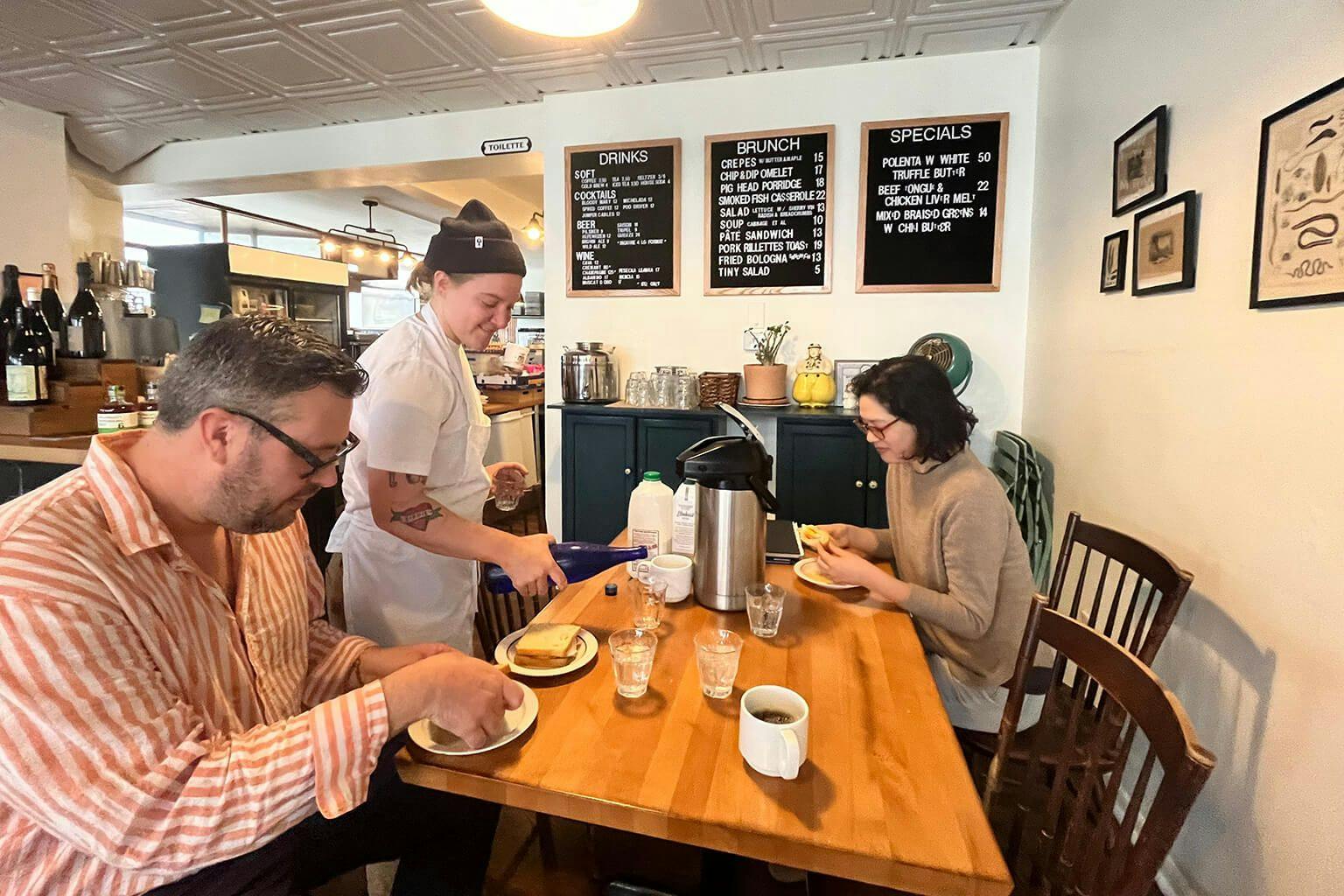Nowadays when you see a respected food publication like Bon Appetit recommend a new restaurant, you’re inclined to think that you’ll be immediately smacked with grandeur when you walk through its doors. But that’s exactly what you won’t find at Chef Shaina Loew-Banayan’s Cafe Mutton, the place that writer Elezar Sontag dubbed “America’s most delightfully unpredictable new restaurant,” and The New York Times named among the top 50 most exciting restaurants of 2022.
You’ll walk into this rustic Hudson, New York, eatery on the corner of Columbia and 8th and be greeted by some very ordinary wooden tables and chairs. You’ll see plates of food that are deceivingly simple, and you may even wonder if you entered some random person’s kitchen by mistake.
But then you’ll notice oat and mutton porridge on the daily brunch menu, and below that, smoked fish casserole. Or if you stop by for the once-weekly dinner service, perhaps some braised monkfish and escarole in brown butter vinaigrette. (Although you may not, as the menu changes seasonally.)
You’ll find quirky knickknacks on the shelves, like a painted, wood-carved hard-boiled egg with legs. And if you peer behind the counter into the open kitchen, you’ll spy a copy of “Gundel’s Hungarian Cookbook,” or a picture book of medieval hunting scenes. This endearing, odd, humble restaurant will charm and intrigue you, and if you have the chance to speak with Chef Loew-Banayan, you might just make a new friend.

Chef Loew-Banayan treats Balas Brothers film crew and Tippsy staff to a pre-shoot breakfast. | Photo by Taylor Markarian.
At first glance, this might seem like the last place one would expect to find sake, but actually, when Tippsy takes over the tavern-esque cafe on a brisk October morning to film for the Tippsy chef series, we are not the first to bring Japan’s national beverage into the mix. Always searching firmly outside the box for new flavors, Chef Loew-Banayan has put Terada Honke’s funky, brown rice “Musubi” sake on their menu once before.
“Somebody did yet another article about food in the Hudson Valley,” Loew-Banayan says, “and the one thing I appreciated them saying was that our food is category defying. And I was like, I’m gonna use that now because I don’t ever know how to answer these questions, and if I can just say we defy categories, then you’ll just have to come see for yourself.”
On this day, Chef is happy to try something new and pair Amabuki “Gin no Kurenai” with a pork sirloin sandwich topped with Tomme de Savoie cheese, roasted plums, whole-grain mustard, onions and aioli. The combination of tart, savory, fruity, salty and rich flavors of the sandwich end up being the ideal match for this pink-hued junmai sake, which has its own notes of flowers, juniper and raspberry — almost like a dry rose wine.
“I knew I wanted to work with a fattier, gamier meat that would kind of behave like a duck breast,” they explain. “I’m getting this little blueberry muffin flavor happening. I think it’s the combination of the fruit with this particular tart Tomme de Savoie cheese that I used, and the richness from the sake. I think it all works really well with the intense flavor of this pork.”
In general, junmai sake tends to have richer flavors than other types of sake because of its lower rice polishing ratio, which suits robust dishes like this one quite well. As for the meat, Chef gladly takes off-cuts from nearby Kindherhook Farm that other restaurants neglect, which is great for preventing wastefulness as well as for inspiring creativity. This is where they can really put their imagination and love of meat to good use, crafting unusual, elevated versions of familiar meals.

Photo by Taylor Markarian.
But even if you’re not a wizard in the kitchen, this kind of food and sake pairing is one you can easily try at home.
“I think that there are a lot of entry points to doing a sandwich like this one,” Chef Loew-Banayan says, “or even a dish that has the same flavors. I think that there’s a lot of possibilities with cheese. A lot of people have some form of deli meat or ham or something similar in their fridge — even a duck pate or something. A lot of people have jam in their fridge already, or mustard … And so this is something people can kind of recreate in their own homes pretty easily.”
Because sake is a Japanese drink, people often assume that it should be drunk alongside Japanese food. And yes, that is a naturally satisfying pairing, but sake’s umami component makes it an excellent pairing beverage for all types of cuisine. That’s not just our opinion, but chemistry: Sake has several times more succinic acid and lactic acid than wine does, making it a better match for ingredients such as seafood and cheese. So not only is sake wonderful with sushi, but it’s also fantastic with lobster, crab, pizza and the meat lover’s creations at Cafe Mutton.
“Something that’s fascinating to me about the sake, which is different from wine and beer, is that the sake and food share [a] savory [quality]. Whereas beer and wine sometimes have a little bit of a savory side going on, it’s not nearly to the extent that the sake does. So it’s really something that I hope that I can continue to do more, because I think that there’s a lot of possibility, especially with the food that I like to make.”
So do yourself a favor, and go savor Cafe Mutton’s indulgent, savory, category-defying dishes. Who knows, depending on the day, you might even be able to order a glass of sake with your meal. But even if you can’t, you can watch Loew-Banayan cook in our video, order a bottle of junmai to your home, and take a crack at it yourself.









